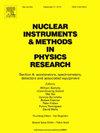Investigation of the dielectric properties of materials obtained by substituting the Ca2+ ion in the compound CaCu3Ti4O12 with Na+ and Bi3+ ions
IF 1.5
3区 物理与天体物理
Q3 INSTRUMENTS & INSTRUMENTATION
Nuclear Instruments & Methods in Physics Research Section A-accelerators Spectrometers Detectors and Associated Equipment
Pub Date : 2025-03-22
DOI:10.1016/j.nima.2025.170452
引用次数: 0
Abstract
This paper presents the results of an experimental investigation into the dielectric properties of NaCu2.5Ti4.5O12, NaBi1/3Cu3Ti4O12, and Bi2/3Cu3Ti4O12 from the family CaCu3Ti4O12 (CCTO). The study involved substituting the Ca2+ ion in CaCu3Ti4O12 with Na+, Bi3+, and a combination of Na+ and Bi3+ ions. The impact of the valence state and ionic radius of the substituting ions on the dielectric properties of these materials was examined. X-ray phase analysis confirmed the stoichiometric correctness of the considered compounds. Temperature and frequency dependencies of the dielectric characteristics of the studied materials were presented. The importance of resonance phenomena, including observations of negative dielectric constant, was highlighted. At a measurement frequency of 1 MHz, graphical illustrations of the voltage dependence of dielectric constant for all samples were provided. Notably, the significant changes in dielectric constant values for Bi-containing materials within the voltage range of 100 mV to 1 V suggest their potential use as sensitive varicaps. Electron microscopic images of the structure of ceramic samples are presented which is important for understanding the studied dielectric properties.
求助全文
约1分钟内获得全文
求助全文
来源期刊
CiteScore
3.20
自引率
21.40%
发文量
787
审稿时长
1 months
期刊介绍:
Section A of Nuclear Instruments and Methods in Physics Research publishes papers on design, manufacturing and performance of scientific instruments with an emphasis on large scale facilities. This includes the development of particle accelerators, ion sources, beam transport systems and target arrangements as well as the use of secondary phenomena such as synchrotron radiation and free electron lasers. It also includes all types of instrumentation for the detection and spectrometry of radiations from high energy processes and nuclear decays, as well as instrumentation for experiments at nuclear reactors. Specialized electronics for nuclear and other types of spectrometry as well as computerization of measurements and control systems in this area also find their place in the A section.
Theoretical as well as experimental papers are accepted.

 求助内容:
求助内容: 应助结果提醒方式:
应助结果提醒方式:


